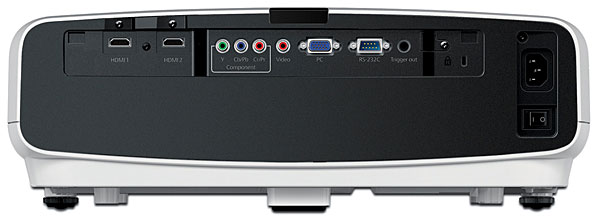Epson 5030UBe 3D LCD Projector

AT A GLANCE
Plus
Excellent contrast and black level for LCD
Capable of powerful brightness
Good overall 2D and 3D performance
Minus
Wireless transmitter needs to be in same space as projector
THE VERDICT
Powerful light output and contrast combined with impressive 3D make the 5030UBe a great projector option at an affordable price.
When Sound&Vision reviewed the Epson 5030UBe’s predecessor, the 5020UBe, in 2013, we were impressed by its exceptional brightness and its ability to convey satisfying blacks. Clearly, LCD projection has come a long way in a short time. Home theater projectors like the 5020UBe tend to get reviewed in a cluster with models from companies like JVC and Sony, and while the Epson ultimately didn’t match its LCOS competition when it came to contrast (JVC) or color accuracy (Sony), overall it held up extremely well—especially considering that the Epson cost several hundred dollars less and offers significantly greater brightness than either of those options.
Now we have the 5030UBe, which costs about the same as the 5020UBe and is spec’d for the same light output. What, if anything, has changed on the new projector?

The main difference appears to be contrast ratio, with the new Epson spec’d for 600,000:1 versus the older model’s 320,000:1. Manufacturer contrast ratio claims being what they are (often suspect, though Epson says that the boost is real and due to tighter tolerances in the light-blocking capabilities of the 5030UBe’s iris), what else has the new Epson got? There’s a B&W Cinema “color mode” for watching classic movies. Also, the wireless HD transmitter that comes with the projector has an MHL input that can be used with devices like a Roku stick, which gives you instant access to a heap of video streaming apps. Other than that, the two projectors appear to be the same, right down to the $2,899 MSRP.
Setup
The 5030UBe looks nice enough, with a sliding lens door that automatically opens when you power it on and closes when you power it off. Focus, zoom, and lens offset controls are all manual and need to be adjusted by hand (fortunately, most people will only have to do this once). With a 100-inch-wide 16:9 screen, the Epson’s throw distance range is 9.8 to 20.9 feet. For my setup, I used an 80-inch-wide screen with the projector positioned 13 feet away on a shelf positioned directly in line with the screen’s top edge. One thing worth noting here is that the 5030UBe lacks an anamorphic stretch mode that would allow the projector to be used in a constant image height setup with an external anamorphic lens/2.35:1 screen. (To get that, you’ll have to upgrade to the company’s 6030UB model.)
 There are two lamp settings on the 5030UBe in THX mode: Normal and Extra Bright. With Normal selected, fan noise is almost inaudible; with Extra Bright, noise increases to the point where you’ll notice and might be bothered by it. The 5030UBe also has two automatic iris modes: Normal and High Speed. According to Epson, the projector’s auto iris feature is controlled by a “high-speed motorized dual-shutter butterfly iris that varies light output up to 60 times per second according to average picture levels.” Also, that “iris response time has been doubled for even better picture level tracking and enhancement.” Whatever’s going on, it works: I didn’t notice any contrast fluctuations with the auto iris enabled, and the contribution it made toward deepening black levels could be both validated visually and measured.
There are two lamp settings on the 5030UBe in THX mode: Normal and Extra Bright. With Normal selected, fan noise is almost inaudible; with Extra Bright, noise increases to the point where you’ll notice and might be bothered by it. The 5030UBe also has two automatic iris modes: Normal and High Speed. According to Epson, the projector’s auto iris feature is controlled by a “high-speed motorized dual-shutter butterfly iris that varies light output up to 60 times per second according to average picture levels.” Also, that “iris response time has been doubled for even better picture level tracking and enhancement.” Whatever’s going on, it works: I didn’t notice any contrast fluctuations with the auto iris enabled, and the contribution it made toward deepening black levels could be both validated visually and measured.
Inputs located on the 5030UBe’s back panel include two HDMI, component/composite video, and a 15-pin PC-RGB port. Not that you’ll need these if you’re using Epson’s wireless HD transmitter—the main reason for buying this model instead of the $300-cheaper 5030UB. The transmitter has five HDMI inputs, including one that can be used with MHL-compatible smartphones and devices like the Roku stick mentioned above. The transmitter also has a USB port to power up the included active 3D glasses (you get two pair free with the 5030UBe).
Epson specs the wireless range of its HD transmitter at 32 feet. In my setup, it was located less than 10 feet from the projector and for the most part worked fine with only an occasional video dropout. What didn’t work was when I tried to place the transmitter behind a closed door in another room—signal reception dropped to zero percent. During my testing, I didn’t see any difference between a wired and wireless connection—an observation I backed up by viewing resolution test patterns.
Since the 5030UBe is THX certified for 2D/3D viewing, the THX 2D and 3D picture modes were the ones I started out and stuck with. As with most THX picture modes, the default settings were in the ballpark, but they benefitted from additional adjustment. Fortunately, the Epson allows you to do this for all picture setup parameters even in THX mode (not all THX-certified displays do). It also provides 10 custom picture memories where you can store and rename settings for later recall.






























































